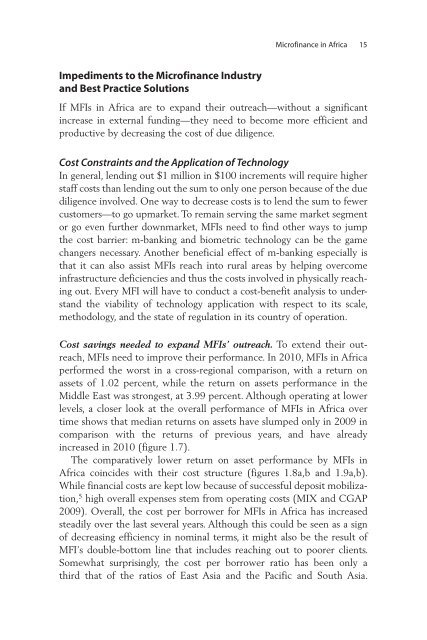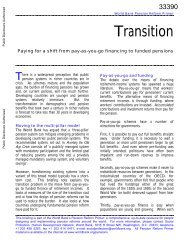Financial Sector Development in Africa: Opportunities ... - World Bank
Financial Sector Development in Africa: Opportunities ... - World Bank
Financial Sector Development in Africa: Opportunities ... - World Bank
You also want an ePaper? Increase the reach of your titles
YUMPU automatically turns print PDFs into web optimized ePapers that Google loves.
Microf<strong>in</strong>ance <strong>in</strong> <strong>Africa</strong> 15<br />
Impediments to the Microf<strong>in</strong>ance Industry<br />
and Best Practice Solutions<br />
If MFIs <strong>in</strong> <strong>Africa</strong> are to expand their outreach—without a significant<br />
<strong>in</strong>crease <strong>in</strong> external fund<strong>in</strong>g—they need to become more efficient and<br />
productive by decreas<strong>in</strong>g the cost of due diligence.<br />
Cost Constra<strong>in</strong>ts and the Application of Technology<br />
In general, lend<strong>in</strong>g out $1 million <strong>in</strong> $100 <strong>in</strong>crements will require higher<br />
staff costs than lend<strong>in</strong>g out the sum to only one person because of the due<br />
diligence <strong>in</strong>volved. One way to decrease costs is to lend the sum to fewer<br />
customers—to go upmarket. To rema<strong>in</strong> serv<strong>in</strong>g the same market segment<br />
or go even further downmarket, MFIs need to f<strong>in</strong>d other ways to jump<br />
the cost barrier: m-bank<strong>in</strong>g and biometric technology can be the game<br />
changers necessary. Another beneficial effect of m-bank<strong>in</strong>g especially is<br />
that it can also assist MFIs reach <strong>in</strong>to rural areas by help<strong>in</strong>g overcome<br />
<strong>in</strong>frastructure deficiencies and thus the costs <strong>in</strong>volved <strong>in</strong> physically reach<strong>in</strong>g<br />
out. Every MFI will have to conduct a cost-benefit analysis to understand<br />
the viability of technology application with respect to its scale,<br />
methodology, and the state of regulation <strong>in</strong> its country of operation.<br />
Cost sav<strong>in</strong>gs needed to expand MFIs’ outreach. To extend their outreach,<br />
MFIs need to improve their performance. In 2010, MFIs <strong>in</strong> <strong>Africa</strong><br />
performed the worst <strong>in</strong> a cross-regional comparison, with a return on<br />
assets of 1.02 percent, while the return on assets performance <strong>in</strong> the<br />
Middle East was strongest, at 3.99 percent. Although operat<strong>in</strong>g at lower<br />
levels, a closer look at the overall performance of MFIs <strong>in</strong> <strong>Africa</strong> over<br />
time shows that median returns on assets have slumped only <strong>in</strong> 2009 <strong>in</strong><br />
comparison with the returns of previous years, and have already<br />
<strong>in</strong>creased <strong>in</strong> 2010 (figure 1.7).<br />
The comparatively lower return on asset performance by MFIs <strong>in</strong><br />
<strong>Africa</strong> co<strong>in</strong>cides with their cost structure (figures 1.8a,b and 1.9a,b).<br />
While f<strong>in</strong>ancial costs are kept low because of successful deposit mobilization,<br />
5 high overall expenses stem from operat<strong>in</strong>g costs (MIX and CGAP<br />
2009). Overall, the cost per borrower for MFIs <strong>in</strong> <strong>Africa</strong> has <strong>in</strong>creased<br />
steadily over the last several years. Although this could be seen as a sign<br />
of decreas<strong>in</strong>g efficiency <strong>in</strong> nom<strong>in</strong>al terms, it might also be the result of<br />
MFI’s double-bottom l<strong>in</strong>e that <strong>in</strong>cludes reach<strong>in</strong>g out to poorer clients.<br />
Somewhat surpris<strong>in</strong>gly, the cost per borrower ratio has been only a<br />
third that of the ratios of East Asia and the Pacific and South Asia.







